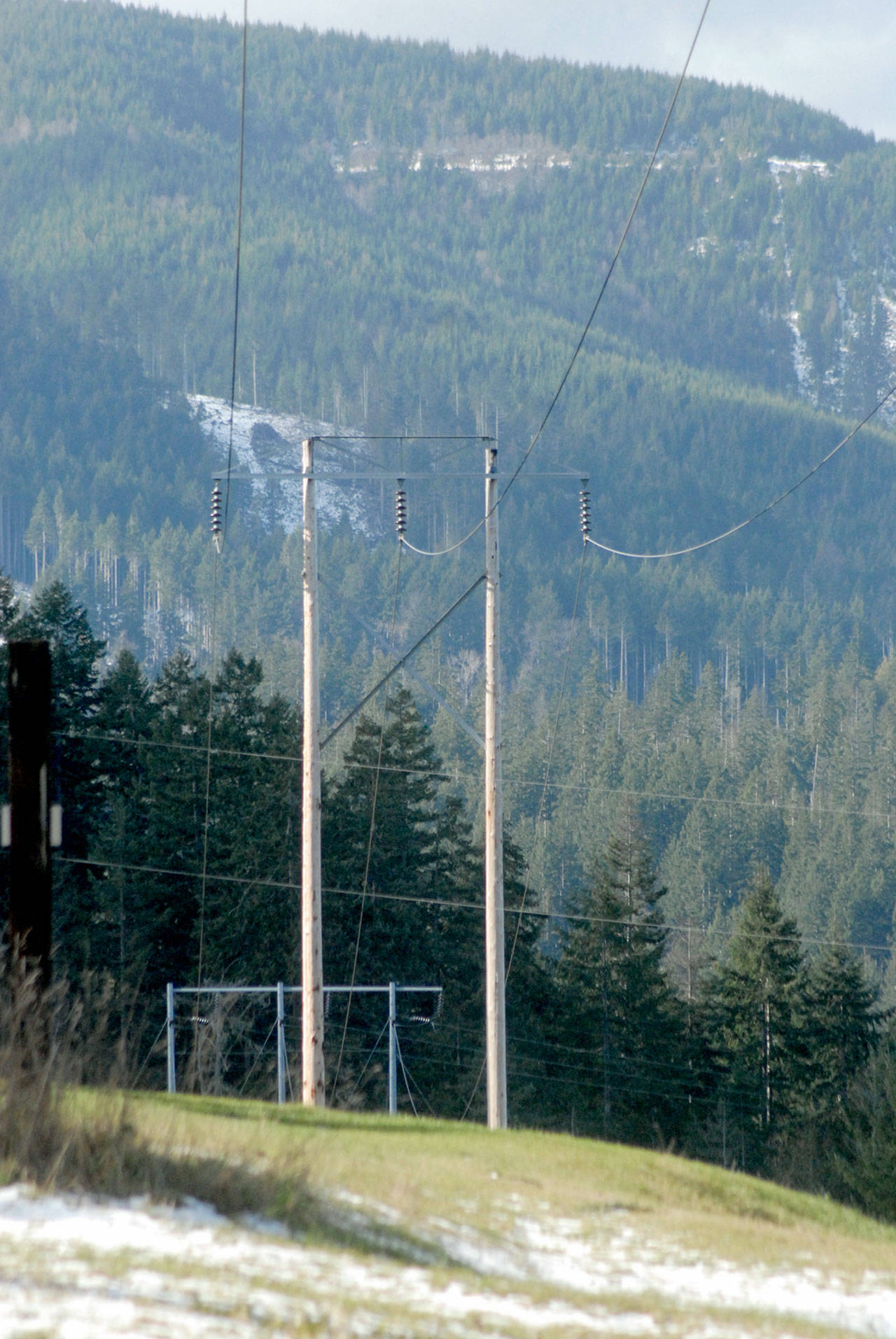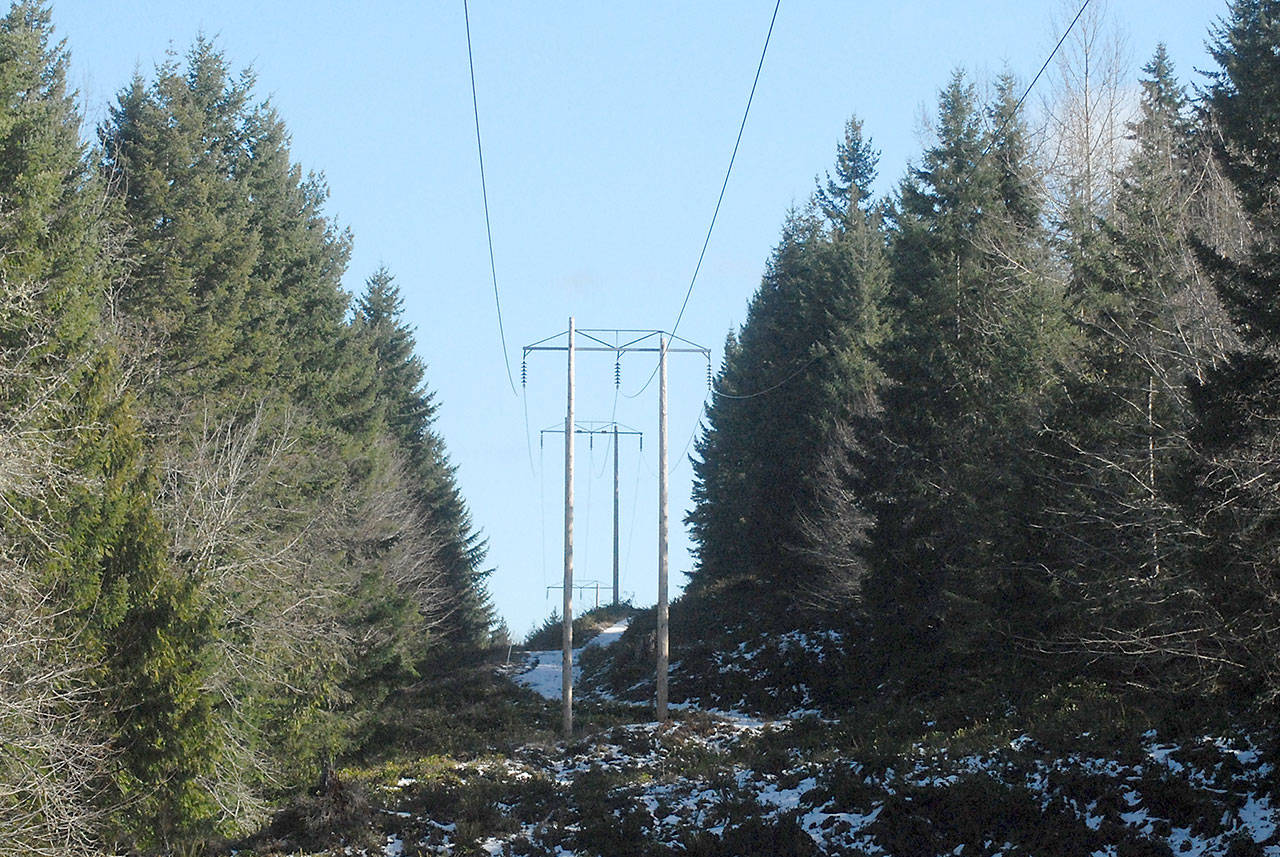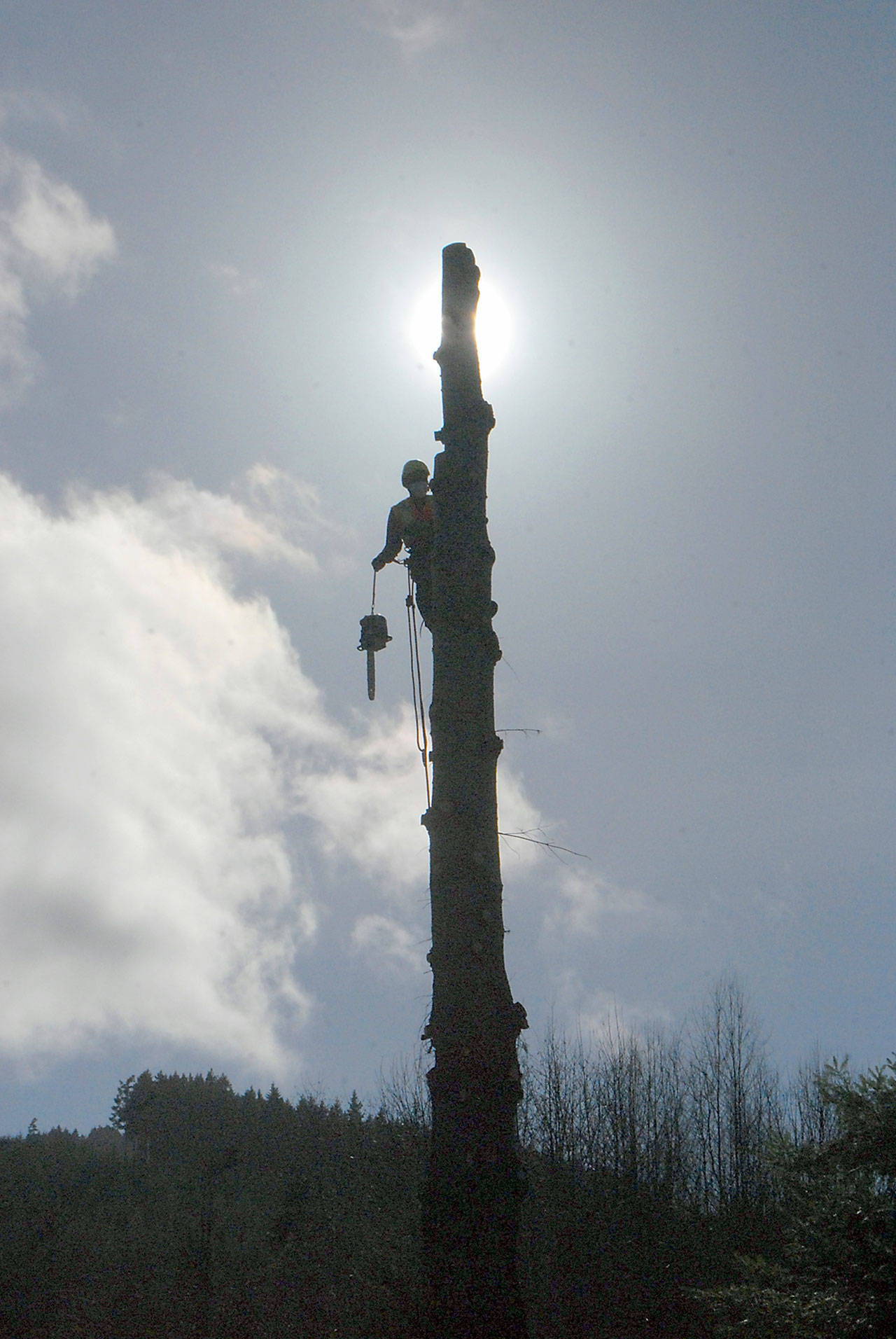PORT ANGELES — If a tree falls in the forest, does it make a sound?
It does if it hits a major power line and blacks out large areas of the North Olympic Peninsula. Electrical power customers will light up the phones wondering when electricity will be restored.
And possibly the most imperiled place for that to happen is a 42-mile stretch of a 115,000-volt transmission line owned by the Bonneville Power Administration that runs from Port Angeles to Sappho.
Severing that vital connection can lead to power loss to most of the West End.
The line makes its way over hills and valleys, through clearings and forested areas, feeding power to Clallam County Public Utility District (PUD) for distribution to the end users in Forks, Neah Bay, Clallam Bay, Sekiu, La Push and points in between.
According to the PUD, almost 5,700 homes and businesses are fed from the Sappho substation.
Lining the 100-foot BPA right-of-way are countless thousands of trees, many of which can potentially topple into the overhead cables.
The administration’s goal is to mitigate the threat of trees along the power supply corridors that guard the lines.
John Tyler, chief forester for the BPA, said about 1,500 potentially hazardous trees had been identified along the stretch.
About 400 of those were removed last fall with the rest slated for the weeks to come.
“It’s very important to do vegetation management on these lines, and on this one in particular because it’s a radial feed,” he said, referring to the fact that the transmission line was the sole pathway for electricity to the West End.
“In Forks, there’s no other way to get power, so when a tree hits a line here, that’s a problem.”
Right-of-way
Jason Hunt, regional natural resource specialist for BPA, said the administration’s 100-foot easement was clear of hazardous vegetation, but the peril comes from trees at the edge of the right-of-way.
“We have what’s called ‘danger-tree rights’,” he said. “If we have one where we don’t have those rights, we have to purchase the tree from the property owner in order to take it down.”
BPA spokesperson Doug Johnson said tree clearing was an ongoing concern.
“We do a really, really good job of clearing things out of the actual right-of-way, but then you have these off right-of-way trees that are tall enough to fall into the line,” he said. “And when that happens, the power goes out.”
The Port Angeles to Sappho transmission line crosses U.S. Forest Service and the state Department of Natural Resources territory, as well as private property, Johnson said. Cooperation for BPA to remove problem trees has traditionally been very good.
On Wednesday, a tree maintenance crew from Chehalis-based Corruco Reforestation Inc., took on a danger tree mere yards from the BPA transmission line off Hansen Road just west of Port Angeles.
An attempt that morning to reach trees in a trouble area on U.S. Forest Service land along West Twin Road west of Joyce was scrubbed due to heavy snow on the access road and left for later when conditions improve.
In less than an hour, the Hansen Road tree was denuded of branches and reduced to a stump with a pile of wood and debris near the base.
One less tree to knock out the lights.
Tyler said the Port Angeles-to-Sappho stretch was particularly prone to tree intrusion because of the nature of the landscape, soggy soil and high winds.
Many trees that may appear healthy often suffer from root rot from poor drainage, making them particularly susceptible to toppling.
The line is inspected at least twice a year by crews that either drive or walk the entire length of the power corridor. Additional inspections take place by helicopter and by satellite Light Detection and Ranging (LiDAR) measurements.
The location of potentially troublesome trees are noted and the trees are tagged for eventual removal, Tyler said.
“We took our best professional guess as foresters to determine which ones had a likelihood of having 50 percent or greater failure rate over the next five years and we marked them,” he said. “We’re now in the process of removing more than a thousand trees.”
Nicole Hartman, communications and government relations manage for Clallam PUD, said her agency has its own vegetation maintenance crews, one stationed on the West End, that perform similar tree-clearing operations to protect its lines that fan out to its customers.
Although PUD isn’t equipped to work on BPA’s high-voltage power lines, both agencies help each other in locating trouble spots.
“If all our crews aren’t dedicated to working on downed trees during an outage, if we have the (extra) people, we can go out to start patrolling their lines to try to get things dialed in and done faster,” Hartman said.
Johnson said the best practice is to remove perils to the powerlines before they become problems under adverse conditions. The BPA has heavy equipment, such as snowcats, that can get to hard-to-reach locations, but it takes time to bring those kinds of assets to where they might be needed.
Additionally, the agency avoids sending crews out in unsafe conditions like windstorms and blizzards, opting instead to wait until the weather improves.
“There’s the actual safety issue of wanting to protect the life of the people you work with,” Johnson said. “These guys are the ones who know how to get to the lines and fix them.
“If something bad happens to them, you have to bring in a crew or other people from other areas, which extends the amount of time.”
Tyler said that crew safety was a top priority of his agency.
“We want to send everyone home to their family at night,” he said.
________
Photojournalist Keith Thorpe can be reached at 360-452-2345, ext. 59050, or at [email protected].
"danger" - Google News
February 21, 2021 at 04:30PM
https://ift.tt/3k7qyhB
BPA takes out 'danger trees' - Peninsula Daily News
"danger" - Google News
https://ift.tt/3bVUlF0
https://ift.tt/3f9EULr





No comments:
Post a Comment